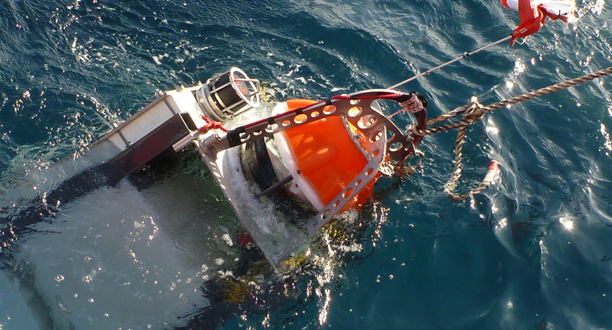A No-Hitter

On board the Mermaid Sapphire off Sydney, Australia
“Mariners call this a confused sea,” Captain Stu Buckle tells me.
An hour before sunrise, the Mermaid Sapphire had slipped out of her berth at the Australian Navy Yard and headed into the great open harbor. Forty minutes later we’re passing through the headlands into a dark-blue ocean with waves riding the crests of 6.6-foot (2-meter) swells. The waves are from the southeast but the swells are coming from three directions. The ship rolls and shifts sideways.
We have two deep-sea landers on board. They’re ten feet (three meters) tall, weigh 1,000 pounds (455 kilograms) each, and are designed to fall through the water, land on the seafloor, and return hours or days later with samples and photographs. Kevin Hardy, a seasoned engineer who worked at Scripps Institution of Oceanography, built them; he’s deployed landers in the Mariana, Aleutian, and Kermadec trenches. The lander we’ll test today was designed specifically for this mission and carries a Canon 5D still camera with a 24mm wide-angle lens inside a pressure-resistant glass sphere.
We steam on a northeast course until we’re 45 miles (72 kilometers) offshore and have 2,625 feet (800 meters) beneath our keel. Kevin and his team—Dave Mitchell, Larry Herbst, and Robby Seed—go through the checklist to ensure the lander is ready for launch. At noon, under a fierce sun, the ship’s big knuckle-boom crane lifts the lander and slides it across the deck toward the starboard bulwark.
As the lander comes off the deck it starts to swing. Dave Wotherspoon directs the deck team to tighten the tag lines, but the lander shifts back and forth as if trying to shake off the lines. Dave’s team hustles it into the water before the movement gets out of control. Rich Robles and Sako Palagin bring the Zodiac in close to the top of the lander and Sako reaches down and unhooks the lift line. A few minutes later, the lander is on its way to the seafloor.
One of our objectives is to use the lander to test the L3 communication system at 2,625 feet (800 meters), but the L3 system isn’t working properly. In an attempt to activate the lights and the camera, the team lowers a slim black cable over the side with a transducer on the end to make acoustic contact with the lander. There is a missed communication between the bridge, and the ship’s stern thruster is activated. In less time than it takes to shout “Stop!” the thruster’s propeller chops up a healthy length of the reinforced Kevlar cable and sends the transducer to the bottom.
We recover the lander at six in the evening. The seas have risen and the Mermaid Sapphire is rolling heavily. The ship, the lander, and the Zodiac move in unpredictable directions and Sako reaches into a big swell and misses his first attempt to hook the lift line into the lander. He turns, grabs a black T-shirt, and wraps it around his left wrist. It looks like he may be injured. On his second attempt he gets the hook secured. After some aggressive seamanship, the deck crew wrangles the lander against the starboard side of the ship, up over the bulwark, and onto the deck.
When Sako comes on board, Dr. Glenn Singleman takes him right into the sick bay. “I’ve got to get back in the boat to help my buddy Rich,” Sako protests, but the doctor prevails. Sako peels away the black T-shirt covering his left arm. Between his wrist and index finger is a four-inch (ten-centimeter) gash oozing blood. There’s a second, shorter gash above it. In a masterful demonstration of seagoing surgery, Glenn uses 12 stitches to close both wounds.
The seas are too rough to safely recover the Zodiac. Rich and Dave Apperly drive the big 500-horsepower boat 45 miles (72 kilometers) back to the Naval Yard.
On this fine day off the east coast of Australia, Mother Ocean held us to a no-hitter. In our six-hour confrontation, she reminded us that she not only bats last, but she owns the stadium.
Photograph by Joe MacInnis



